Overview
- Description
- Consists of a portrait photograph of a teenage girl taped to an enlarged piece of cardboard with description written in pen surrounding the photograph. The text describes the photograph as an pre-war image of Salunia Lipszyc of Łódź, Poland, who went to school with the donor, Dorca Gruenberg.
- Date
-
creation:
1997
- Credit Line
- United States Holocaust Memorial Museum Collection, Gift of the Hatikvah Holocaust Education Center
Physical Details
- Language
- English
- Extent
-
1 oversize folder
Rights & Restrictions
- Conditions on Access
- There are no known restrictions on access to this material.
- Conditions on Use
- Material(s) in this collection may be protected by copyright and/or related rights. You do not require further permission from the Museum to use this material. The user is solely responsible for making a determination as to if and how the material may be used.
Administrative Notes
- Holder of Originals
-
United States Holocaust Memorial Museum
- Legal Status
- Permanent Collection
- Provenance
- Dorca Gruenberg donated this collection to the Hatikvah Holocaust Education Center. This collection was transferred to the United States Holocaust Memorial Museum upon the closure of the Hatikvah Holocaust Education Center in Springfield, MA, in September 2010.
- Record last modified:
- 2023-02-24 13:37:54
- This page:
- https://collections.ushmm.org/search/catalog/irn43818
Download & Licensing
- In Copyright - Use Permitted
- Terms of Use
- This record is not digitized and cannot be downloaded online.
In-Person Research
- Request 7 Days in Advance of Visit
- Plan a Research Visit
-
Request in Shapell Center Reading Room
Bowie, MD
Contact Us
Also in Hatikvah Holocaust Education Center collection
This collection consists of materials originally donated to the Hatikvah Holocaust Education Center in Springfield, MA.
Date: 1927-2005
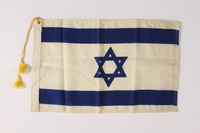
Tasseled Israeli Flag owned by an aid for the mayor of New York City
Object
Small, cloth, Israeli flag with gold colored tassels received by Paul H. Taylor who was an aid to the mayor of New York City , under both Vincent R. Impellitteri and Robert F. Wagner, Jr., from 1951 to 1958. His duties included making arrangements for visiting Jewish dignitaries to the city in the 1950s. Among these visitors were David Ben-Gurion, the primary national founder of the State of Israel and its first Prime Minister, in 1951, Shlomo Zalman Shragai, mayor of Jerusalem, in 1952, and Shalom Kahalny, the marathon runner who carried an Olympic torch to City Hall, in 1956. He also helped host events for visits by the Mayor of Tel Aviv, the Chief Rabbi of Ireland, the Jewish War Veterans of the United States, and several local religious and political leaders.

Theresienstadt ghetto-labor camp scrip, 2 kronen note
Object
Theresienstadt scrip, valued at 2 kronen, owned by Chana Bruder Perlroth during the Holocaust. It was issued in Theresienstadt (Terezin) ghetto-labor camp in 1943. All currency was confiscated from deportees upon entry and replaced with scrip and ration coupons that could be exchanged only in the camp. The currency was designed by inmate Peter Kien and printed by the National Bank of Prague. Inmates received the scrip according to a 5-tiered distribution system or as payment for conscript labor arranged by the Jewish Council of Elders who administered the daily life of the ghetto for the Germans. It is unclear what, if anything, could be purchased with the scrip, which was printed in great volume. The Germans had the scrip issued to instill a sense of normalcy within the huge ghetto. Theresienstadt camp, located in German occupied Czechoslovakia, existed for 3.5 years, from November 24, 1941 to May 9, 1945. Approximately 140,000 Jews were sent to Theresienstadt; nearly 90,000 were deported to near certain death in the east, and roughly 33,000 died, most of disease and starvation.
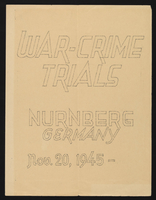
Sidney Cooley collection
Document
The collection documents the post-war experiences of Sidney Cooley, a United States Army serviceman who became the deputy military governor of Bayreuth and later a prosecutor and judge for civilian court trials. Includes Cooley’s military papers including identification cards, a Bronze Star Medal citation, and discharge papers; clippings; and photographs of Cooley in uniform, displaced Jews in Bayreuth, courtroom trials, and the opening of a kibbutz in Zettlitz, Germany.
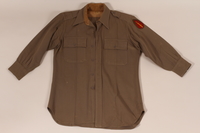
US Army regulation uniform with a 63rd infantry sleeve patch worn by a Jewish soldier
Object
U.S. Army issue tan dress shirt and trousers with a cloth belt worn by Sidney Cooley while he was serving as an officer in the 63rd Infantry Division in the United States and Europe from 1943 - 1945. Nicknamed the Blood and Fire Division, the 63rd’s insignia is inspired by a Winston Churchill quote: “the enemy would bleed and burn in expiation of their crime against humanity.” On January 1, 1945, Sidney’s Division was deployed to Marseilles, France, and quickly advanced north into Germany. The 63rd Infantry crossed the Siegfried Line and fought through central Germany, arriving in Landsberg am Lech by April. Sidney was promoted and assigned to General Louis Hibb’s staff. On May 7, 1945, Germany surrendered. Sidney was promoted to Captain, assigned to the Third Army, and placed on occupational duty in the American zone. He was selected to serve as the deputy military governor in Bayreuth. He assisted with regional rebuilding efforts and with the de-Nazification program. Sidney, a lawyer by training, served as prosecutor for the U.S. military government in Bayreuth, as well as a judge, hearing approximately 1,800 cases involving civilian violations of military government. As a Yiddish speaking, Jewish American official, Sidney’s presence in Bayreuth attracted many displaced Holocaust survivors looking for a place to settle while waiting to emigrate. Among his efforts to help the community, was the establishment of an agrarian training program to train more than 300 hopeful Palestinian settlers and prepare them for life as farmers. Sidney worked very closely with the Jewish community and when he left Bayreuth, they thanked him with an eloquent citation.
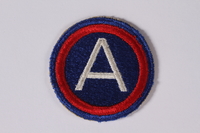
US Third Army shoulder sleeve patch with an AO worn by a Jewish soldier
Object
Shoulder sleeve badge, Third Army, worn by Captain Sidney Cooley while he was serving as an army officer and military government official in Bayreuth, Germany, from 1945 – 1946. The insignia utilizes the national colors and the design is an “AO,” which stands for Army of Occupation to honor the Army’s post WWI mission. On January 1, 1945, Sidney’s Division was deployed to Marseilles, France, and quickly advanced north into Germany. The 63rd Infantry crossed the Siegfried Line and fought through central Germany, arriving in Landsberg am Lech by April. Sidney was promoted and assigned to General Louis Hibb’s staff. On May 7, 1945, Germany surrendered. Sidney was promoted to Captain, assigned to the Third Army, and placed on occupational duty in the American zone. He was selected to serve as the deputy military governor in Bayreuth. He assisted with regional rebuilding efforts and with the de-Nazification program. Sidney, a lawyer by training, served as prosecutor for the U.S. military government in Bayreuth, as well as a judge, hearing approximately 1,800 cases involving civilian violations of military government. As a Yiddish speaking, Jewish American official, Sidney’s presence in Bayreuth attracted many displaced Holocaust survivors looking for a place to settle while waiting to emigrate. Among his efforts to help the community, was the establishment of an agrarian training program to train more than 300 hopeful Palestinian settlers and prepare them for life as farmers. Sidney worked very closely with the Jewish community and when he left Bayreuth, they thanked him with an eloquent citation.
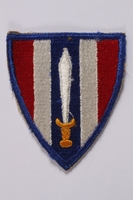
US Army, European Civil Affairs Division shoulder sleeve patch worn by a Jewish soldier
Object
Shoulder sleeve badge, European Civil Affairs Division, worn by Captain Sidney Cooley while he was serving as an Army officer and military government official in Bayreuth, Germany, from 1945 -1946. The insignia’s shield shape and sword are symbolic of the flaming sword of avenging justice used on the Supreme Allied Expeditionary Force (SHAEF) insignia. On January 1, 1945, Sidney’s Division was deployed to Marseilles, France, and quickly advanced north into Germany. The 63rd Infantry crossed the Siegfried Line and fought through central Germany, arriving in Landsberg am Lech by April. Sidney was promoted and assigned to General Louis Hibb’s staff. On May 7, 1945, Germany surrendered. Sidney was promoted to Captain, assigned to the Third Army, and placed on occupational duty in the American zone. He was selected to serve as the deputy military governor in Bayreuth. He assisted with regional rebuilding efforts and with the de-Nazification program. Sidney, a lawyer by training, served as prosecutor for the U.S. military government in Bayreuth, as well as a judge, hearing approximately 1,800 cases involving civilian violations of military government. As a Yiddish speaking, Jewish American official, Sidney’s presence in Bayreuth attracted many displaced Holocaust survivors looking for a place to settle while waiting to emigrate. Among his efforts to help the community, was the establishment of an agrarian training program to train more than 300 hopeful Palestinian settlers and prepare them for life as farmers. Sidney worked very closely with the Jewish community and when he left Bayreuth, they thanked him with an eloquent citation.
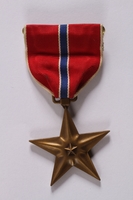
Bronze Star medal with ribbon presented to a Jewish US soldier
Object
Bronze Star Medal awarded to Sidney Cooley for heroic, meritorious achievement as a US Army officer in Europe from January 1945 to September 1946. On January 1, 1945, Sidney’s Division was deployed to Marseilles, France, and quickly advanced north into Germany. The 63rd Infantry crossed the Siegfried Line and fought through central Germany, arriving in Landsberg am Lech by April. Sidney was promoted and assigned to General Louis Hibb’s staff. On May 7, 1945, Germany surrendered. Sidney was promoted to Captain, assigned to the Third Army, and placed on occupational duty in the American zone. He was selected to serve as the deputy military governor in Bayreuth. He assisted with regional rebuilding efforts and with the de-Nazification program. Sidney, a lawyer by training, served as prosecutor for the U.S. military government in Bayreuth, as well as a judge, hearing approximately 1,800 cases involving civilian violations of military government. As a Yiddish speaking, Jewish American official, Sidney’s presence in Bayreuth attracted many displaced Holocaust survivors looking for a place to settle while waiting to emigrate. Among his efforts to help the community, was the establishment of an agrarian training program to train more than 300 hopeful Palestinian settlers and prepare them for life as farmers. Sidney worked very closely with the Jewish community and when he left Bayreuth, they thanked him with an eloquent citation.
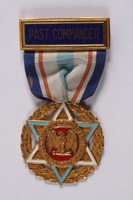
Jewish War Veterans Past Commander medal and ribbon issued to a US soldier
Object
Past Commander Medal awarded to Sidney Cooley by the Jewish War Veterans of the United States for his postwar service as a member of the organization. On January 1, 1945, Sidney’s Division was deployed to Marseilles, France, and quickly advanced north into Germany. The 63rd Infantry crossed the Siegfried Line and fought through central Germany, arriving in Landsberg am Lech by April. Sidney was promoted and assigned to General Louis Hibb’s staff. On May 7, 1945, Germany surrendered. Sidney was promoted to Captain, assigned to the Third Army, and placed on occupational duty in the American zone. He was selected to serve as the deputy military governor in Bayreuth. He assisted with regional rebuilding efforts and with the de-Nazification program. Sidney, a lawyer by training, served as prosecutor for the U.S. military government in Bayreuth, as well as a judge, hearing approximately 1,800 cases involving civilian violations of military government. As a Yiddish speaking, Jewish American official, Sidney’s presence in Bayreuth attracted many displaced Holocaust survivors looking for a place to settle while waiting to emigrate. Among his efforts to help the community was the establishment of an agrarian training program to train more than 300 hopeful Palestinian settlers and prepare them for life as farmers. Sidney worked very closely with the Jewish community and when he left Bayreuth, they thanked him with an eloquent citation.

Deggendorf displaced persons camp scrip, 25 cents, acquired by a US soldier
Object
Deggendorf displaced persons camp scrip, valued at 25 cents, acquired by Captain Sidney Cooley while he was serving as an officer in the US Third Army and military government in Bayreuth, Germany, from 1945 -1946. On January 1, 1945, Sidney’s Division was deployed to Marseilles, France, and quickly advanced north into Germany. The 63rd Infantry crossed the Siegfried Line and fought through central Germany, arriving in Landsberg am Lech by April. Sidney was promoted and assigned to General Louis Hibb’s staff. On May 7, 1945, Germany surrendered. Sidney was promoted to Captain, assigned to the Third Army, and placed on occupational duty in the American zone. He was selected to serve as the deputy military governor in Bayreuth. He assisted with regional rebuilding efforts and with the de-Nazification program. Sidney, a lawyer by training, served as prosecutor for the U.S. military government in Bayreuth, as well as a judge, hearing approximately 1,800 cases involving civilian violations of military government. As a Yiddish speaking, Jewish American official, Sidney’s presence in Bayreuth attracted many displaced Holocaust survivors looking for a place to settle while waiting to emigrate. Among his efforts to help the community, was the establishment of an agrarian training program to train more than 300 hopeful Palestinian settlers and prepare them for life as farmers. Sidney worked very closely with the Jewish community and when he left Bayreuth, they thanked him with an eloquent citation.
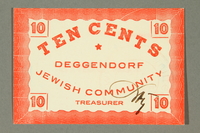
Deggendorf displaced persons camp scrip, 10 cents, acquired by a US soldier
Object
Deggendorf displaced persons camp scrip, valued at 10 cents, acquired by Captain Sidney Cooley while he was serving as an officer in the US Third Army and military government in Bayreuth, Germany, from 1945 -1946. On January 1, 1945, Sidney’s Division was deployed to Marseilles, France, and quickly advanced north into Germany. The 63rd Infantry crossed the Siegfried Line and fought through central Germany, arriving in Landsberg am Lech by April. Sidney was promoted and assigned to General Louis Hibb’s staff. On May 7, 1945, Germany surrendered. Sidney was promoted to Captain, assigned to the Third Army, and placed on occupational duty in the American zone. He was selected to serve as the deputy military governor in Bayreuth. He assisted with regional rebuilding efforts and with the de-Nazification program. Sidney, a lawyer by training, served as prosecutor for the U.S. military government in Bayreuth, as well as a judge, hearing approximately 1,800 cases involving civilian violations of military government. As a Yiddish speaking, Jewish American official, Sidney’s presence in Bayreuth attracted many displaced Holocaust survivors looking for a place to settle while waiting to emigrate. Among his efforts to help the community, was the establishment of an agrarian training program to train more than 300 hopeful Palestinian settlers and prepare them for life as farmers. Sidney worked very closely with the Jewish community and when he left Bayreuth, they thanked him with an eloquent citation.
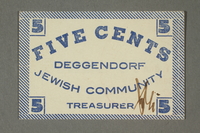
Deggendorf displaced persons camp scrip, 5 cents, acquired by a US soldier
Object
Deggendorf displaced persons camp scrip, valued at 5 cents, acquired by Captain Sidney Cooley while he was serving as an officer in the US Third Army and military government in Bayreuth, Germany, from 1945 -1946. On January 1, 1945, Sidney’s Division was deployed to Marseilles, France, and quickly advanced north into Germany. The 63rd Infantry crossed the Siegfried Line and fought through central Germany, arriving in Landsberg am Lech by April. Sidney was promoted and assigned to General Louis Hibb’s staff. On May 7, 1945, Germany surrendered. Sidney was promoted to Captain, assigned to the Third Army, and placed on occupational duty in the American zone. He was selected to serve as the deputy military governor in Bayreuth. He assisted with regional rebuilding efforts and with the de-Nazification program. Sidney, a lawyer by training, served as prosecutor for the U.S. military government in Bayreuth, as well as a judge, hearing approximately 1,800 cases involving civilian violations of military government. As a Yiddish speaking, Jewish American official, Sidney’s presence in Bayreuth attracted many displaced Holocaust survivors looking for a place to settle while waiting to emigrate. Among his efforts to help the community, was the establishment of an agrarian training program to train more than 300 hopeful Palestinian settlers and prepare them for life as farmers. Sidney worked very closely with the Jewish community and when he left Bayreuth, they thanked him with an eloquent citation.
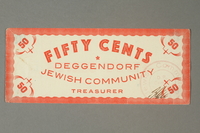
Deggendorf displaced persons camp scrip, 50 cents, acquired by a US soldier
Object
Deggendorf displaced persons camp scrip, valued at 50 cents, acquired by Captain Sidney Cooley while he was serving as an officer in the US Third Army and military government in Bayreuth, Germany, from 1945 -1946. On January 1, 1945, Sidney’s Division was deployed to Marseilles, France, and quickly advanced north into Germany. The 63rd Infantry crossed the Siegfried Line and fought through central Germany, arriving in Landsberg am Lech by April. Sidney was promoted and assigned to General Louis Hibb’s staff. On May 7, 1945, Germany surrendered. Sidney was promoted to Captain, assigned to the Third Army, and placed on occupational duty in the American zone. He was selected to serve as the deputy military governor in Bayreuth. He assisted with regional rebuilding efforts and with the de-Nazification program. Sidney, a lawyer by training, served as prosecutor for the U.S. military government in Bayreuth, as well as a judge, hearing approximately 1,800 cases involving civilian violations of military government. As a Yiddish speaking, Jewish American official, Sidney’s presence in Bayreuth attracted many displaced Holocaust survivors looking for a place to settle while waiting to emigrate. Among his efforts to help the community, was the establishment of an agrarian training program to train more than 300 hopeful Palestinian settlers and prepare them for life as farmers. Sidney worked very closely with the Jewish community and when he left Bayreuth, they thanked him with an eloquent citation.
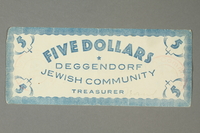
Deggendorf displaced persons camp scrip, 5 dollars, acquired by a US soldier
Object
Deggendorf displaced persons camp scrip, valued at 5 dollars, acquired by Captain Sidney Cooley while he was serving as an officer in the US Third Army and military government in Bayreuth, Germany, from 1945 -1946. On January 1, 1945, Sidney’s Division was deployed to Marseilles, France, and quickly advanced north into Germany. The 63rd Infantry crossed the Siegfried Line and fought through central Germany, arriving in Landsberg am Lech by April. Sidney was promoted and assigned to General Louis Hibb’s staff. On May 7, 1945, Germany surrendered. Sidney was promoted to Captain, assigned to the Third Army, and placed on occupational duty in the American zone. He was selected to serve as the deputy military governor in Bayreuth. He assisted with regional rebuilding efforts and with the de-Nazification program. Sidney, a lawyer by training, served as prosecutor for the U.S. military government in Bayreuth, as well as a judge, hearing approximately 1,800 cases involving civilian violations of military government. As a Yiddish speaking, Jewish American official, Sidney’s presence in Bayreuth attracted many displaced Holocaust survivors looking for a place to settle while waiting to emigrate. Among his efforts to help the community, was the establishment of an agrarian training program to train more than 300 hopeful Palestinian settlers and prepare them for life as farmers. Sidney worked very closely with the Jewish community and when he left Bayreuth, they thanked him with an eloquent citation.
Whitney R. Harris presentation
Document
Consists of a DVD of a presentation by Whitney R. Harris about his experiences as a prosecutor at Nuremberg, at the Hatikvah Holocaust Education Center on October 2, 2005. The presentation, introduced by Senator Christopher Dodd, is entitled "A Reason to Remember."
Jim Miller collection
Document
Consists of seven photographs taken after the liberation of the Nordhausen concentration camp depicting corpses lined up in front of crumbling buildings and the burial of corpses. The photographs are stamped as being passed by an Army Examiner and are among those which were mass produced.
Winofker family collection
Document
Consists of correspondence, documents, and identity cards related to the lives of Rachela Winofker and her sons, Mendel and Szloma, in the Foehrenwald and Bad Reichenhall displaced persons camps in 1947-1948. Includes correspondence, in Yiddish, from family members in the United States, and documentation collected in preparation for immigration to the United States, including official immigration identity cards. Also includes a official photograph of Hitler and other Nazi officials at an unknown event in 1936 and a note from Menachem Begin to Luba Gurdus in 1978, thanking her for sending a copy of her book.
Chana Perlroth documents
Document
Consists of documents related to the Holocaust experiences of Chana Bruder Perlroth, including two copies of 1941 document ordering her to present herself, with identification, at a certain date and time and her 1940 identification certificate, listing her birthdate as 1888. Also includes one piece of Theresienstadt scrip and an 1943 Arbeits-pass (work pass) for Almtmina Steen (nee Saathoff), born in Hesel in 1904, who was working in Leer, Ostfriesland, Germany.
Stanley Garfinkle collection
Document
Consists of 46mass-produced photoprints, some with captions, depicting the destruction of buildings and military equipment in Europe, the deaths of enemy combatants, USO entertainers (including Bob Hope), and images of the architecture and of survivors of the Dachau concentration camp. The photographs were collected by Stanley Garfinkle.
Photograph of workers in Olkusz, Poland
Document
Consists of one photograph of a group of workers in Olkusz, Poland, circa 1930.
Richard Towne collection
Document
The Richard Towne collection consists of correspondence between American businessman Richard P. Towne and German businessman Herman Ebhardt, between 1927-1937. In the correspondence, the men discuss the politics in their respective countries, the leadership of Franklin Roosevelt and Adolf Hitler, and the persecution of Jews in Germany. Also includes Richard H. Towne's notes on his memories of the relationship between Ebhardt and Towne's father, as well as correspondence with, and photographs of, Ebhardt's family in the 1960s and 1970s.
Morris Katz collection
Document
Consists of documents, photographs, photocopies, and photographic negatives from the collection of Morris Katz, who was a medic in the United States Army during World War II. Includes photographs of France and Germany during and after the war, as well as photographs taken at the liberation of Buchenwald along with a notepad of handwritten captions. Includes documents from his military career and photographs of his family, which he carried with him in Europe.



